
Advice and Support: The Early Years, 1941-1960
Ronald H. Spector
Advice and Support describes the activities of the U.S. Army in Vietnam during World War II, military advice and assistance to the French government during the immediate postwar years, and the advisory program that developed after the Geneva Agreements of 1954. Its scope ranges from high-level policy decisions to low-echelon advisory operations in the field, presented against a background of relevant military and political developments. Useful not only as a study of military assistance but as a view of the Army as an agent of national policy, Ronald Spector's interesting book is a fitting introduction to the overall study of the conflict in Vietnam.
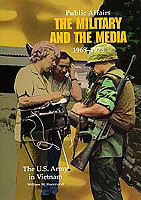
Public Affairs: The Military and the Media, 1968-1973
William M. Hammond
Public Affairs: The Military and the Media, 1968-1973, the sequel volume to William M. Hammond's Public Affairs: The Military and the Media, 1962-1968, continues the history and analysis of the relationship between the press and the military during the final years of the Vietnam conflict. Relying on official records and histories, news media sources and interviews, and significant secondary works, Hammond has carefully and capably traced the many turns that public affairs policies and campaigns took to protect military secrets without diminishing the independence of news correspondents. Massive amounts of information were forthcoming without endangering U.S. forces, but neither the press nor the government was totally satisfied with the system. Doubts and criticisms loomed large, giving rise to tensions and disagreements. With some exceptions, the military and the news media became enemies. What happened in Vietnam between the military and the news media was symptomatic of what had occurred in the United States as a whole. Hammond's well-written account raises the issues and problems that can confront an open society at war, documenting events and precedents that will continue to affect military-media relations during future operations. It offers important lessons for soldiers, newsmen, policymakers, and the public at large.
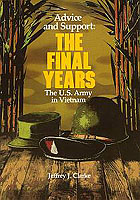
Advice and Support: The Final Years, 1965-1973
Jeffrey J. Clarke
In Advice and Support: The Final Years, 1965-1973, Jeffrey J. Clarke describes the U.S. Army advisory effort to the South Vietnamese armed forces during the period when the U.S. commitment in Southeast Asia was at its peak. The account encompasses a broad spectrum of activities at several levels, from the physically demanding work of the battalion advisers on the ground to the more sophisticated undertakings of our senior military officers at the highest echelons of the American military assistance command in Saigon. Among critical subjects treated are our command relationships with the South Vietnamese army, our politico-military efforts to help reform both the South Vietnamese military and government, and our implementation of the Vietnamization policy inaugurated in 1969. The result tell us much about the U.S. Army's role as an agent of national policy in a critical but often neglected arena, and constitutes a major contribution to our understanding of not only events that occurred in Vietnam, but also the decisions and actions that produced them.

Combat Operations: Taking the Offensive, October 1966 to October 1967
George L. MacGarrigle
Combat Operations: Taking the Offensive chronicles the onset of offensive operations by the U.S. Army after eighteen months of building up a credible force on the ground in South Vietnam and taking the first steps toward bringing the war to the enemy. The compelling story by George L. MacGarrigle begins in October 1966, when General William C. Westmoreland believed that he had the arms and men to take the initiative from the enemy and that significant progress would be made on all fronts over the next twelve months. Aware of American intentions, North Vietnam undertook a prolonged war of attrition and stepped up the infiltration of its own troops into the South. While the insurgency in the South remained the cornerstone of Communist strategy, it was increasingly overshadowed by main-force military operations. These circumstances, according to MacGarrigle, set the stage for intensified combat. The North Vietnamese and Viet Cong units retained the advantage, fighting only when it suited their purposes and retreating with impunity into inviolate sanctuaries in Laos and Cambodia. With Westmoreland feeling hamstrung by political constraints on his ability to wage war in the vast hostile areas along the border, 1967 ended with a growing uncertainty in the struggle to secure the countryside. Relying on official American and enemy primary sources, MacGarrigle has crafted a well-balanced account of this year of intense combat. His volume is a tribute to those who sacrificed so much in a long and irresolute conflict, and soldiers engaged in military operations that place great demands on their initiative, skill, and devotion will find its thought-provoking lessons worthy of reflection.
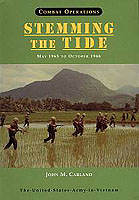
Combat Operations: Stemming the Tide, May 1965 to October 1966
John M. Carland
Combat Operations: Stemming the Tide describes a critical chapter in the Vietnam conflict, the first eighteen months of combat by the U.S. Army's ground forces. Relying on official American and enemy primary sources, John M. Carland focuses on initial deployments and early combat and takes care to present a well-balanced picture by discussing not only the successes but also the difficulties endemic to the entire effort. This fine work presents the war in all of its detail: the enemy's strategy and tactics, General William C. Westmoreland's search and destroy operations, the helicopters and airmobile warfare, the immense firepower American forces could call upon to counter Communist control of the battlefield, the out-of-country enemy sanctuaries, and the allied efforts to win the allegiance of the South Vietnamese people to the nation's anti-Communist government. Carland's volume demonstrates that U.S. forces succeeded in achieving their initial goals, but unexpected manpower shortages made Westmoreland realize that the transition from stemming the tide to taking the offensive would take longer. Bruising battles with the Viet Cong and North Vietnamese in the Saigon area and in the Central Highlands had halted their drive to conquest in 1965 and, with major base development activities afoot, a series of high-tempo spoiling operations in 1966 kept them off balance until more U.S. fighting units arrived in the fall. Carland credits the improvements in communications and intelligence, the helicopter's capacity to extend the battlefield, and the availability of enormous firepower as the potent ingredients in Westmoreland's optimism for victory, yet realizes that the ultimate issue of how effective the U.S. Army would be and what it would accomplish during the next phase was very much a question mark.
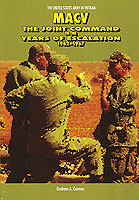
MACV: The Joint Command in the Years of Escalation, 1962-1967
Graham A. Cosmas
MACV describes the evolution of the command during the period of gradual expansion of the American effort in South Vietnam. From its establishment in 1962 as a small, temporary organization to administer an assistance program, the Military Assistance Command, Vietnam, grew by late 1967 into a large, permanent headquarters that directed more than half a million American soldiers, sailors, airmen, and marines in a wide range of combat and pacification operations. Graham A. Cosmas tells the story of MACV's development as an organization and of the command's role in making and implementing American national policy in Southeast Asia. The volume treats both national-level decisions and military operations from the perspective of the theater joint commander. It recounts how the MACV commander and his staff viewed the war at various periods and how and why they arrived at their decisions. The volume analyzes the interservice politics of organizing and managing a joint command; MACV's relationship with Pacific Command, the Joint Chiefs of Staff, and the secretary of defense; and the evolution of the command's dealings with its South Vietnamese and third-country allies. As an experiment in nation-building, the story of the Military Assistance Command contains many parallels to more recent Army engagements and so serves as a potential source of important lessons.
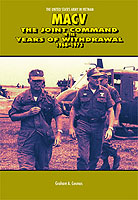
MACV: The Joint Command in the Years of Withdrawal, 1968-1973
Graham A. Cosmas
MACV: The Joint Command in the Years of Withdrawal, 1968-1973, describes the evolution of the command during the period of U.S. disengagement from Vietnam. By late 1967 the Military Assistance Command, Vietnam (MACV), had grown from a small, temporary advisory and assistance organization into a large, permanent headquarters that directed more than half a million American soldiers, sailors, airmen, and marines in a wide range of combat and pacification operations. By that same time, however, President Lyndon B. Johnson and his principal advisers had concluded that it was necessary to begin reducing the cost in lives and money of a seemingly stalemated war. The Communist Tet offensive of January-February 1968 confirmed the president in his decision and set the United States upon a path of disengagement that President Richard M. Nixon also followed. During the period covered by this volume, MACV gradually withdrew its American troops from South Vietnam and worked to prepare Saigon's forces to defend their country by their own efforts. The MACV headquarters itself drew down toward reversion to an assistance and advisory group.
This volume tells the story of MACV's evolution as an organization and of the command's role in making and implementing American national policy in Southeast Asia during the period of U.S. disengagement from the Vietnam War. It treats both national-level decisions and military operations from the perspective of the theater joint commander.

Military Communications: A Test for Technology
John D. Bergen
In Military Communications: A Test for Technology, John D. Bergen develops the thesis that burgeoning technology in communications faced a severe test in Vietnam. He analyzes the advantages and drawbacks of new communications systems and the effects these systems had on decision making and on command. In doing so, he describes the difficulties that communications systems had in keeping pace with the information explosion and shows that command and control do not necessarily improve with enhanced communications. The book illustrates that the communicator's missions of "getting the message through" was not only critical to the success of combat operations, but also as challenging as combat itself. Bergen's clear understanding and description of these issues make this a valuable work for those responsible for the future success of command, control, communications, and intelligence.
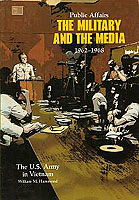
Public Affairs: The Military and the Media, 1962-1968
William M. Hammond
The Military and the Media examines the evolution of the U.S. government's public affairs policies in Vietnam between 1962 and 1968. Adopting a broad viewpoint in order to depict the many influences - civilian and military, political and diplomatic - that bore upon the conduct of public affairs, the William Hammond's insightful work describes the tensions that developed between the institutions of the press and the military as the war grew and as each served its separate ends. The book observes events from the perspective of the Military Assistance Command's Office of Information in Saigon, which carried much of the burden of press relations, but necessarily considers as well the role of the White House, the State and Defense Departments, and the U.S. embassy in Saigon in the creation of information policy. By drawing together many disparate strands, the book seeks to delineate some of the issues and problems that can confront an open society whenever it wages war.

Engineers at War
Adrian G. Traas
Engineers at War describes the role of military engineers, especially the U.S. Army Corps of Engineers, in the Vietnam War. It is a story of the engineers' battle against an elusive and determined enemy in one of the harshest underdeveloped regions of the world. Despite these challenges, engineer soldiers successfully carried out their combat and construction missions. The building effort in South Vietnam allowed the United States to deploy and operate a modern 500,000-man force in a far-off region. Although the engineers faced huge construction tasks, they were always ready to support the combat troops. They built ports and depots, carved airfields and airstrips out of jungle and mountain plateaus, repaired roads and bridges, and constructed bases. Because of these efforts, ground combat troops with their supporting engineers were able to fight the enemy from well-established bases. Although most of the construction was temporary, more durable facilities, such as airfields, port and depot complexes, headquarters buildings, communications facilities, and an improved highway system, were intended to serve as economic assets for South Vietnam.
This volume covers how the engineers grew from a few advisory detachments to a force of more than 10 percent of the Army troops serving in South Vietnam. The 35th Engineer Group began arriving in large numbers in June 1965 to begin transforming Cam Ranh Bay into a major port, airfield, and depot complex. Within a few years, the Army engineers had expanded to a command, two brigades, six groups, twenty-eight construction and combat battalions, and many smaller units.
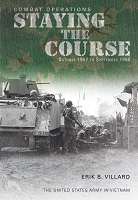
Combat Operations: Staying the Course, October 1967-Septermber 1968
Erik B. Villard
Combat Operations: Staying the Course, September 1967-October 1968, describes the twelve-month period when the Viet Cong and their North Vietnamese allies embarked on a new and more aggressive strategy that shook the foundations of South Vietnam and forced the United States to reevaluate its military calculations in Southeast Asia. Hanoi's general offensive�general uprising brought the war to South Vietnam's cities for the first time and disrupted the allied pacification program that was just beginning to take hold in some rural areas formerly controlled by the Communists. For the enemy, however, those achievements came at a staggering cost in manpower and material; more importantly, the Tet offensive failed to cripple the South Vietnamese government or convince the United States to abandon its ally. As the dust settled from the Viet Cong attacks, President Lyndon B. Johnson ordered his military commanders to press ahead with their current strategy unchanged apart from some short-term tactical adjustments and a modest increase in the U.S. troop deployment. His decision to stay the course seemed to bear fruit as the allies repaired their losses and then forged new gains throughout the summer and autumn of 1968. Even so, the allied situation at the end of this period appeared to be only marginally better than it had been in late 1967; the peace talks in Paris had stalled, and American public opinion had turned decisively against the war.